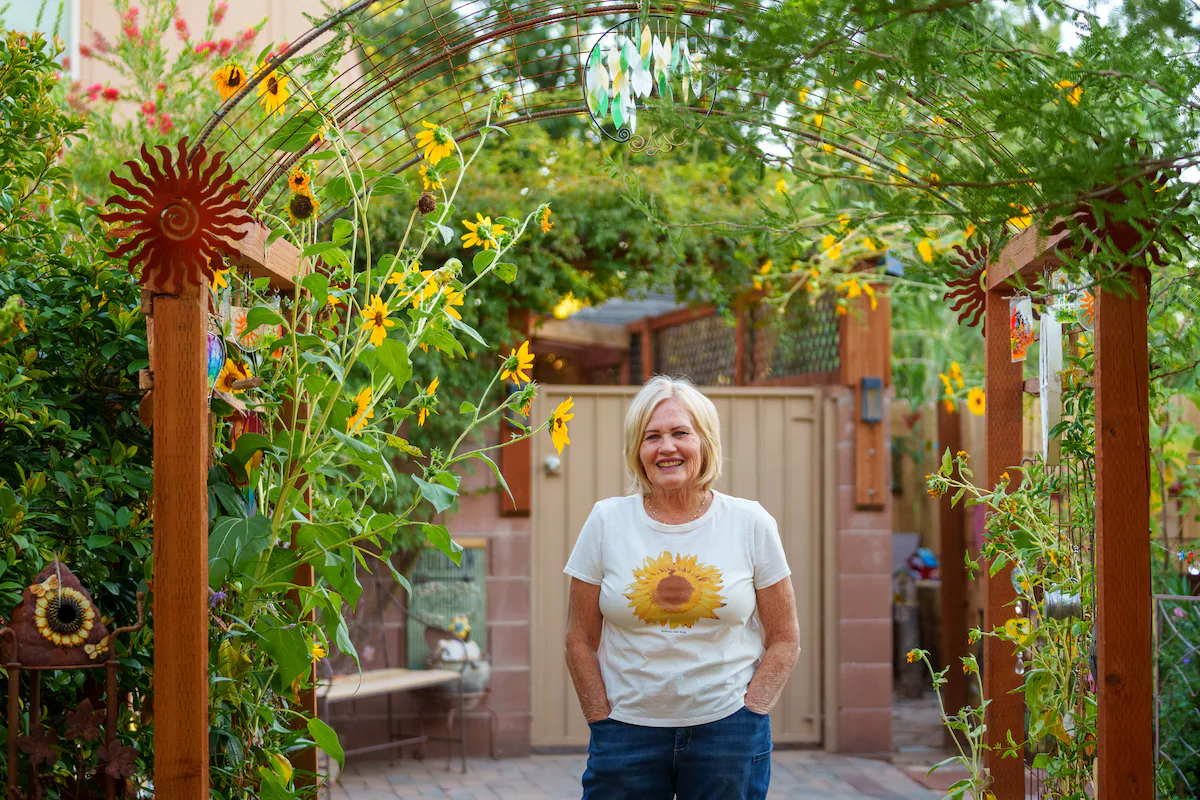
Chris Frehner wasn’t a fan of tomatoes until about a decade ago.
“I was living in a home that had a tomato plant, and I was like, I hate tomatoes,” he said. “And then I had a tomato off of the tomato plant, and I was like, I love tomatoes.”
That first tasty homegrown tomato sparked a desire in Frehner to further explore gardening.
Now, vines dotted with orange sungolds — his children’s favorite tomato variety — sprawl across raised beds he built himself. Nearby, grapevines weave along the fence and pomegranate, peach, apple, pear, cherry, plumb and fig trees provide fruit and shade.
Frehner is one of 11 gardeners featured in the second annual Parade of Gardens Southern Utah taking place September 19-21. This self-guided tour features homes with water-wise landscaping across Washington County. Conserve Southwest Utah, with support from the Washington County Water Conservancy District, organizes the event to show other desert dwellers how they might be able to transform their own yards.
“The parade of gardens is just showing the possibilities,” said Karen Goodfellow, water program manager and organizer of the event with Conserve Southwest Utah.
Much of Washington County is currently in extreme drought. The area has implemented ambitious water conservation measures, including incentives for removing grass and prohibitions on lawns in new commercial, institutional and industrial developments except where a recreation area is appropriate, such as a sports complex. The standards also limit lawns in new residential developments to 8% of the lot size or 2,500 square feet — whichever is less.
One family featured in this year’s Parade of Gardens, Melissa and Ryan Darling, took advantage of the district’s rebate program, which pays residents up to $2 per square foot of lawn converted to water-wise landscaping.
Not all homes in the Parade of Gardens are completely lawn free, though. Frehner, for example, has a patch that he plans to rip out eventually but not until his older dog has passed. “I have a dog that’s 14 years old, so I am not taking her grass from her,” he said.
Grass doesn’t dominate Frehner’s yard, though; it’s rather interspersed with drought-tolerant plants and trees that provide shade and produce edible fruit.
“You don’t have to do it all,” Goodfellow said. “You can do one little part of your garden. You can do one little corner and plant a tree. You can do it in stages.”
Creating a culture of abundance
Frehner attended the first Parade of Gardens last year and said he was “pretty inspired by what people had done.”
“I felt like that inspiration was akin to the inspiration of tasting that first [homegrown] tomato,” he added.
Now, he hopes his own garden may inspire others who participate in this year’s tour.
Sharing ideas and knowledge is at the heart of the Parade of Gardens. “That’s part of what we want to do as a community, is share,” said Goodfellow.
That culture of exchange isn’t limited to landscaping ideas. Frehner hands out his grapes and peaches and another neighbor reciprocates with ears of corn.
“We’re creating the village again,” Goodfellow said.
Beyond food, Frehner also shares young cacti plants he grew from seed that cover his kitchen counter. “That’s one of the bonuses of coming to Chris’: you get a cactus when you leave,” said Bonnie Pendleton, a gardening consultant known in the community as “the plant lady.”
Pendleton grew up working in her grandparents’ garden in Washington County. She’s seen southwest Utah transform from food-producing fields to large housing developments with lawns and now a revitalization of more edible landscapes and native plants. “I feel like we’ve turned the corner and we’re going back to our roots again,” she said.
She attributes the change to the growing interest in gardening and farming among young people, as well as COVID, during which more people spent time in their yard.
“They went into their backyard, and they thought, okay, if we have to stay somewhere isolated for a long time, it might as well be a nice yard, might as well have food in it that we can eat,” she said.
Pendleton has connected Goodfellow with her gardening clients who are a good fit for the parade, including Cril and Mark Cochran.
Cril has also leaned into the culture of sharing. She’s exchanged starter plants with friends and neighbors, as well as bought plants from other gardeners for prices significantly less than what she could find in stores.
“One neighbor sells cacti for 30 or 40 bucks that a nursery may sell for 200,” she said. Now the west side of her house is lined with cacti that bloom bright flowers at different times of the year.
Having fun
Beyond cacti, Mexican petunias and oleander shrubs also bring pops of purple and pink to the Cochrans’ yard. Mesquite and locust trees provide shade, and over 7,000 pavers that the Cochrans laid themselves provide pathways through little nooks with metal yard art and kid-sized chairs for their grandchildren.
“My grandkids have so much fun when they come here on this new trail,” she said as she gestured to a path she recently laid.
The Cochrans also built a greenhouse out of wood they reclaimed from construction sites, which are numerous in rapidly growing Washington County. Inside the greenhouse, broccoli, cauliflower, spinach, tomatoes and other veggies grow throughout the year.
“Just start doing it and allow it to happen,” she said as advice for other gardeners. “I didn’t know I could create this. I’ve always liked gardening, but I didn’t know. I just started having so much fun with it. And just be creative, be brave, and don’t worry about it.”



